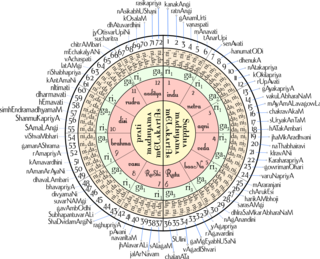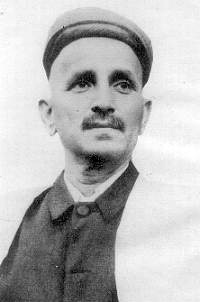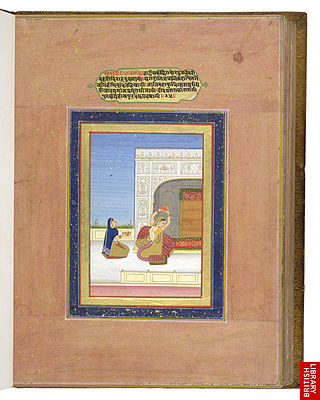Related Research Articles

A raga is a melodic framework for improvisation in Indian classical music akin to a melodic mode. Rāga is central to classical Indian music. Each rāga consists of an array of melodic structures with musical motifs; and, from the perspective of the Indian tradition, the resulting music has the ability to "colour the mind" as it engages the emotions of the audience.

Indian classical music is the classical music of the Indian subcontinent. It is generally described using terms like Shastriya Sangeet and Marg Sangeet. It has two major traditions: the North Indian classical music known as Hindustani and the South Indian expression known as Carnatic. These traditions were not distinct until about the 15th century. During the period of Mughal rule of the Indian subcontinent, the traditions separated and evolved into distinct forms. Hindustani music emphasizes improvisation and exploration of all aspects of a raga, while Carnatic performances tend to be short composition-based. However, the two systems continue to have more common features than differences. Another unique classical music tradition from the eastern part of India is Odissi music, which has evolved over the last two thousand years.
Hindustani classical music is the classical music of the Indian subcontinent's northern regions. It may also be called North Indian classical music or Uttar Bhartiya shastriya sangeet. The term shastriya sangeet literally means classical music, and is also used to refer to Indian classical music in general. It is played on instruments like the veena, sitar and sarod. It diverged in the 12th century CE from Carnatic music, the classical tradition of Southern India. While Carnatic music largely uses compositions written in Sanskrit, Kannada, Telugu, Tamil, Malayalam, Hindustani music largely uses compositions written in Hindi, Urdu, Braj, Avadhi, Bhojpuri, Bengali, Rajasthani, Marathi and Punjabi.
A thaat is a "parent scale" in North Indian or Hindustani music. It is the Hindustani equivalent of the term Melakartha raga of Carnatic music. The concept of the thaat is not exactly equivalent to the western musical scale because the primary function of a thaat is not as a tool for music composition, but rather as a basis for classification of ragas. There is not necessarily strict compliance between a raga and its parent thaat; a raga said to 'belong' to a certain thaat need not allow all the notes of the thaat, and might allow other notes. Thaats are generally accepted to be heptatonic by definition.

Pandit Vishnu Narayan Bhatkhande was an Indian musicologist who wrote the first modern treatise on Hindustani classical music, an art which had been propagated for centuries mostly through oral traditions. During those earlier times, the art had undergone several changes, rendering the raga grammar documented in scant old outdated texts.

Kalyani is a melakarta raga in the Carnatic music. It was called Kalyan but is now more popularly called Yaman in Hindustani Music. Its Western equivalent is the Lydian mode.

Khamaj is a Hindustani classical Music raga within the Khamaj thaat which is named after it.
Darbari Kanada, or simply Raga Darbari, is a raga in Carnatic music. It is a janya ragam of 20th Melakarta raga Natabhairavi. Being an ancient raga, its original name is unknown. It is believed to be borrowed into Hindustani classical music by Miyan Tansen, the famous 16th-century composer in emperor Akbar's court. It belongs to the Kanada family. This tradition is reflected in the name itself; Darbar is the Persian derived word in Hindi meaning "court." As the most familiar raga in the Kanada family, it may sometimes also be called Shuddha Kanada or pure Kanada. It belongs to the Asavari thaat. This raag is called raaga Kaanada in Yakshagana Karnataka state dance. It is also sometimes written as Durbari and Durbarikanada.
Ahir Bhairav is a Hindustani classical raga. It is a mixture of Bhairav and the ancient, rare raga Ahiri or Abhiri, or perhaps a mixture of Bhairav and Kafi.
Bahar is a Hindustani classical raga. This raga is very similar to raga Malhar. This raga is from the Kafi Thaat.

Kafi is a raga in Hindustani classical music. It corresponds to Kharaharapriya in Carnatic music and Dorian mode in Western music
Pilu or Peelu is a raga of Hindustani classical music. It is mostly used in light-classical forms, like thumris.

Purvi or Poorvi is a raga in Hindustani classical music that exemplifies its own thaat, the Poorvi thaat. Purvi has a deeply serious, quiet and somewhat mystical character. It is uncommon in performances nowadays.
Shrikrishna Narayan Ratanjankar born 31 December 1899 and died 14 February 1974. He was a distinguished scholar and teacher of Hindustani classical music, from the Agra gharana. Foremost disciple of Vishnu Narayan Bhatkhande and Faiyaz Khan of Baroda State, he also remained principal of Bhatkhande Music Institute, Lucknow, for many years, where he trained many noted names in the field of music.

Marva or Marwa portrays being with one's lover and is often portrayed in Ragamala paintings as two couples kissing. It is a hexatonic Indian raga; Pa is omitted. Marva is the eponymous raga of the Marva thaat.

Miyan ki Todi, often simply referred to as Todi or Darbari Todi, is a Hindustani classical raga which gave its name to the Todi thaat, one of the ten types of classical music according to the musicologist Bhatkhande. Ragas from the Todi raganga include Todi itself, Bilaskhani Todi, Gujari Todi, Desi Todi, Hussaini Todi, Asavari Todi, and Bahaduri Todi.
Yaman is a heptatonic (sampurna) Indian classical raga of Kalyan Thaat.
Kalavati or Kalawati is a modern pentatonic Hindustani classical raga. Svaras Re and Ma are strictly omitted (Varjya/Varjit). Kalavati belongs to the Khamaj Thaat.
Gopeshwar Banerjee or Gopeshwar Bandopadhyay (1880–1963) was an Indian classical singer and musicologist, belonging to Bishnupur gharana of Hindustani music, which originated in Bishnupur in West Bengal. He was known for his khyal and dhrupad renditions, besides Rabindra Sangeet. He also sang thumri, and most notably the thumri, Kon Gali Gayo Shyam, in Raga Mishra Khamaj, which he popularised. As a musicologist, he published several books of rare compositions with musical notations, including dhrupad and Rabindra Sangeet.
Kirwani is a musical scale in Hindustani classical music. It is an Indian raga specially suited for instrumental music. The scale is the same as the harmonic minor in western music. There are shades of Pilu in Kirwani. This raga is said to have been borrowed from the Carnatic music raga Keeravani.